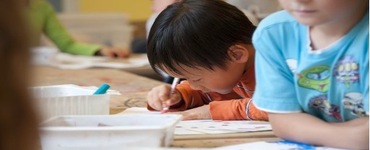In this perspective article, we offer our opinion that immersion education is a promising solution to Minnesota’s school integration efforts. In light of this, we also consider the critiques that exist in this type of language programming, and the tensions that school districts and administrators must grapple with in consideration of the intended goals of immersion language education and both state- and nationwide educational aims.
Keywords: immersion education, educational policy, school integration, desegregation
Segregation, desegregation, and integration in Minnesota schools
School districts across the State of Minnesota – and the United States at large – are working to address racial, ethnic, and class segregation by better integrating their schools. Current integration efforts naturally draw on the Brown v. Board of Education case (1954), with its historical ruling to desegregate public schools in the United States. Leading up to and out of Brown, “[o]ne of the fundamental justifications used by desegregation proponents in the 1960s was the promise of improved academic performance for students of color” (Mattheis, 2009, p. 1), and it has been the consensus across many fields that segregation is inherently unequal (Anderson, 2005). At the same time, a tension exists as there is persistent evidence that “[desegregation] has fallen out of favor even among those who would count themselves committed to educational equity” (Mattheis, 2009, p. 2). In some cases, this is due to findings that students of color and economically disadvantaged students experience improved academic performance before their schools are integrated (Mayo, 2007); in other cases, when programs gain attention for the academic achievement of all of their students, they begin to be gentrified by White communities (Williams, 2017) whose families engage in “opportunity hoarding” (Uzzell & Ayscue, 2021, p. 23), which leads to fewer educational opportunities for students of color. In consideration of Minnesota’s own integration efforts, this tension between segregation, desegregation, and integration is an important consideration.
Reframing the issue as one of “integration” rather than “desegregation,” Minnesota policymakers and educators have worked to advance the concept of integration as a means of promoting “meaningful interracial contact” and “cultural competency” within an educational policy arena made complicated by school choice legislation, declining public school enrollment, and the economic disparities that exist among Twin Cities metro area cities and towns (Mattheis, 2009, p. 2). Minnesota’s Achievement and Integration legislation (§124D.861, 2022) – and its established oversight responsibilities through the Minnesota Department of Education – submits all Minnesota schools to a revision of their enrollment through the lens of protected class status.1 Minnesota Administrative Rule 3535.0110, subpart 6 finds that a racially identifiable school “means a school where the enrollment of protected students at the school within a district is more than 20 percentage points above the enrollment of protected students in the entire district for the grade levels served by that school;” subpart 7 finds that a racially isolated school district means a district “where the districtwide enrollment of protected students exceeds the enrollment of protected students of any adjoining district by more than 20 percentage points.” The intention of the statute, by default, brings the consideration of programs that predominantly benefit students of color and economically disadvantaged students to the forefront. As school districts look for ways to integrate their schools, they turn to a variety of options that will attract students and families from a diverse range of race, ethnicity, and class with the hope of ultimately shifting enrollment to drop below the 20 percentage point discrepancy stated in the Minnesota Rule. Oftentimes, all manner of magnet programs are considered, such as STEM (science, technology engineering, and math), the arts, or International Baccalaureate (Mattheis, 2009); not least among these are language immersion programs.
In this perspective article, we share our agreement that immersion education (particularly two-way immersion, described below) is a promising solution to Minnesota’s school integration efforts. We begin by defining key terms in immersion language programming and explaining the different types of immersion school contexts. In light of this, we also consider the critiques that exist in this type of language programming, and the tensions that school districts and administrators must grapple with in consideration of the intended goals of immersion language education and both state- and nationwide educational aims.
What is immersion education? Defining key terms and school contexts
According to a survey by the American Councils for International Education (2021), there are approximately 3,600 immersion schools currently operating in the U.S – a stark increase compared to the 79 programs in operation 25 years ago (Fortune & Jorstad, 1996); in Minnesota, there are over 100 of these programs. Lyster (2007, p. 8) defines immersion as:
a form of bilingual education that aims for additive bilingualism by providing students with a sheltered classroom environment in which they receive at least half of their subject-matter instruction through the medium of a language that they are learning as a second, foreign, heritage, or indigenous language. In addition, they receive some instruction through the medium of [the majority language] in the community.
According to Tedick and Lyster (2020), immersion programs are often categorized as either being strong, which leads to additive bilingualism, or as being weak, which leads to subtractive bilingualism. Additive bilingualism refers to when an additional language is acquired “at no expense to the first language” whereas subtractive bilingualism refers to the loss of one language in the process of learning another (Tedick & Lyster, 2020, p. 2).
Tedick and Lyster (2020) propose that there are four types of strong, additive bilingual programs that fall under the umbrella term of dual language immersion (DLI) programming: one-way immersion, one-way developmental bilingual immersion, two-way immersion, and indigenous language revitalization immersion. One-way immersion programs – also commonly referred to as foreign or second language immersion programs – generally serve homogenous majority language students, where majority language is defined as “the language spoken by the majority of people in a given regional or national context” (Center for Advanced Research on Language Acquisition, 2022). In the U.S. context, this refers to English. In contrast to the previous type of DLI program, one-way developmental bilingual immersion programs generally serve linguistically homogeneous minority language students, with the intent being to develop students’ academic English skills in addition to academic skills in their first language. In the U.S., students enrolled in these programs are mostly native speakers of Spanish and, increasingly, Spanish-English bilinguals who grew up speaking both languages from birth. Two-way immersion (TWI) programs – a third type of program – have student populations that combine majority and minority language students and are primarily a U.S. phenomenon (Tedick & Lyster, 2020); in TWI, “the two groups of students should be fairly well balanced, with each making up approximately half of the student population at each grade, and with neither group falling below one-third of the total at any grade level” (Howard et al., 2003, p. 5). Finally, as its name implies, indigenous language revitalization immersion programs – the last type – serve students with indigenous ancestry and aims to revitalize indigenous languages and cultures (e.g., Dakota, Ojibwe). These immersion programs are the rarest of the four types.
Variation in DLI programming: Models and aims
Whereas there are clear differences between these types of DLI programs, the reality of shifting demographics within school district lines results in student populations that can fluctuate from the normalized or even idealized population make-up. For instance, in TWI programs that serve both language majority and language minority students, it is often difficult for schools to follow the ideal 50/50 split as student population ratios fluctuate each year and, in public school systems, administrators cannot control the demographics of the school district population. In the early stages of TWI, however, a double lottery system and open enrollment were used to attract students from the target populations with that idealized 50/50 split in mind (Fortune & Jorstad, 1996).
There also exists some variation within each type of DLI program regarding how much class instruction is taught in the minority or “partner” language (PL) of the school – 90:10 and 50:50. The design of the 90:10 model means that all students start the program with 90% of the instructional time in the PL and 10% of the instructional time in the majority language (i.e., English). Around the 3rd year (i.e., 3rd grade), the proportion of instructional time in the PL begins to be gradually reduced, and instructional time in English is added. Usually by 5th grade, the instructional time is split evenly between the two languages. The design of the 50:50 model, on the other hand, means that from the very start of the program English and the PL are used half and half in the classroom (Gómez et al., 2005). Kim et al. (2015) reported that the “the 90:10 model is used in about 42% of schools that employ the TWI model, while 33% of the schools using the TWI model employ the 50:50 approach” (p. 242). In an earlier survey (Fortune & Jorstad, 1996), the two designs were referred to as partial immersion (50:50) and full-time immersion (90:10).
In spite of these differences between the amounts of instructional time in the PL (i.e., full or part-time immersion), the central goals of DLI programs remain the same. Howard et al. (2003) describe these goals as:
- all students will develop high levels of proficiency in their first language (L1);
- all students will develop high levels of proficiency in a second language (L2); and
- all students will demonstrate positive cross-cultural attitudes and behaviors.
In addition to developing high levels of proficiency in both languages, an additional goal of DLI programs and/or expectation of students is that the academic performance for all students (both language majority and language minority) will be at or above grade level by 5th grade.
Krueger (2008), like many other researchers, has shown that DLI programs benefit all students. In a case study, African American, Hispanic, Asian, and students who qualified for free or reduced lunch all outperformed their peers across the district as a whole in reading, math, and English language arts as a result of their enrollment in the immersion program. Predictably, White students in the immersion program also outperformed students across the district, but what is more, “the reading performance gap between White and Non-White students was smaller for immersion students relative to district performance as a whole” (Krueger, 2008, para. 6). Such findings make it obvious why immersion would be a top choice for integration when schools are submitted to statutory regulation due to their shifting demographics and enrollments, which seem to indicate racial segregation, and regularly correlate with class segregation.
Two-way immersion as a promising solution for school integration
Researchers focusing on the added goal of high academic achievement (at or above grade level by 5th grade) have attempted to understand the best DLI models and designs to support academic achievement for all students, with particular attention on supporting minority language students commonly referred to as English language learners (ELLs). Large-scale, longitudinal, comparative studies (e.g.; Collier & Thomas, 2002, 2017; Lindholm-Leary, 2001; Thomas & Collier, 1997, 2002) have shown the TWI model to be the most successful for ELLs’ academic achievement in comparison to other DLI program types. In light of these findings, the TWI model has been characterized and described as a promising solution to reducing the achievement gap, especially in response to pressures from several state and federal political pushes and movements (Kim et al., 2015), such as: proposition 227 in California in 1998 (i.e., all students must be taught in English); proposition 203 in Arizona in 2000 (i.e., grades 2-12 must be tested yearly to monitor their progress in academic subjects and in learning English); No Child Left Behind (NCLB) in 2001; and many other “English Only” movements in the 1990s. This promise to address the achievement gap has been especially persuasive to concerned parents and community stakeholders, and it has drawn their attention easily. However, it could be harmful to see TWI as the “golden ticket” to fix the achievement gap as DLI programs are often more accessible for White middle-class students who also gain to benefit from these bilingual programs, thereby (inadvertently) further widening the gap.
Bilingualism for all? Double standards and deficit ideologies of bilingualism
In spite of its purported benefits, it is important for us to note that DLI programs have also been criticized by scholars who maintain that a double standard exists between White bilingualism and racialized bilingualism (e.g., Flores & Rosa, 2015; Flores et al., 2021; García, 2009, 2020). African American students, for instance, have been shown to be systematically excluded or discouraged from such school programs because of deficit ideologies that suggest they are not capable of handling dual language education (Palmer, 2010). Other racially-minoritized students, such as Latinx children, have been commonly described as not fully proficient in either of their languages, thus leading to presumed cognitive deficiencies and an overall deficit model of bilingualism in DLI.
García (2009, 2020) describes such deficit models of bilingualism as resulting from comparisons to monolingual ideologies, which position monolingualism as the norm and bilingualism as double monolingualism. As such, when monolingual White middle-class students learn another language in DLI programs, their additive bilingualism is validated. However, the dynamic bilingualism that is often characteristic of bilingual communities – whose language practices often involve a mixture of two languages – does not fall neatly within the boundaries of so-called “standard languages.” As such, the bilingualism of minoritized children is often depicted as being incomplete and full of errors, especially in school settings that promote the use of a single, standardized language in certain contexts and settings (e.g., content classes in schools).
In alignment with García, Flores and Rosa (2015) argue that in U.S. school settings and elsewhere this double standard is further exacerbated by racist and white supremacist ideologies that position the particular linguistic and cultural practices of the “white speaking and listening subject” (Flores & Rosa, 2015, p. 151) – that is, White children and their families, teachers, and communities – as normative and ideal, whereas other practices are often positioned as deviant and needing to be corrected. As Flores and Rosa show, the value of standardized language practices become anchored in what they term raciolinguistic ideologies, which “conflate certain racialized bodies with linguistic deficiency unrelated to any objective linguistic practices” (Flores & Rosa, 2015, p. 150). In other words, racially-minoritized students are often seen as deficient and linguistically deviant even when engaging in the same practices that would be seen as normative or even exemplary when produced by privileged White students (e.g., strategically using different languages for different social settings, purposes, and intended audiences).
In addition to the double standard to bilingualism that exists between White and racially-minoritized students, DLI programs have also been criticized for their role in racial stratification in U.S. education and local community gentrification. Early on, Valdés (1997) cautioned that “educators need to carefully examine who the main beneficiaries of these language ‘resources’ [i.e., DLI programs] will be” (p. 419), as power imbalances between community members and stakeholders may lead programs to prioritize the needs of affluent White children over the needs of low-income, racially-minoritized children in terms of teaching, curriculum development, and student enrollment/recruitment. She also warned that such programs may disproportionately enrich the educational experiences and economic potential of affluent White children, while doing little to enrich or improve the lives of linguistic minority (e.g., Latinx) children. In light of current Minnesota Achievement and Integration plans, we believe it is extremely important to heed this warning as school districts attempt to address racial, ethnic, and class segregation by integrating schools.
Keys to maintaining integration in an immersion setting
Immersion continues to weather storms and celebrate victories as DLI programs navigate social and political tensions in the United States. While the 1998 California Proposition 227 “effectively eliminated bilingual education for English-learning students” (Williams, 2017, para. 15), integration law across many states find immersion to be fertile ground for the “integration of students from different racial and linguistic backgrounds” (Uzzell & Ayscue, 2021, p. 24), but at what cost? As Anderson (2005) describes, laws centered on desegregation and integration often serve to “[assert] definitional or constitutional equality, while sidestepping the institutional mechanisms of educational inequality, [destroying] the name (segregation) while leaving the game (racial subordination) intact” (p. 31). Immersion finds itself in a tricky predicament: it is a proven approach to education that reduces the impact of systemic racism and oppression by sustaining teaching and learning spaces where diverse students measurably overcome the achievement and opportunity gaps found in English-only programs. However, when demographics begin to show higher numbers of students of color demonstrating positive academic achievement, the programs become more and more appealing to White families who are able to easily displace students of color and/or economically disadvantaged students.
These tensions around race and language in education are increasingly the focus of popular discourse on public education and show up frequently in news coverage and on social media. The previously mentioned Atlantic article by Williams (2017) describes how “[m]ultilingualism is hot, especially in gentrifying urban areas with shifting populations… [and] school districts are using dual-immersion programs to encourage new residents to send their children to schools in their own zip codes and to provide equitable educational opportunities for all kids” (para. 25). Williams goes on to uncover the problem, however, that “in some places, this ultimately results in a system in which English-dominant students get access to Spanish-English dual immersion programs, while native Spanish-speaking students are consigned to English-only programs” (Williams, 2017, para. 30). While at first immersion can serve to integrate, Scanlan and Palmer (2009) point out that more needs to be done: “without directly addressing issues of race and class and explicitly serving children along all lines of diversity preset in a community, [DLI programs] may end up serving the needs of those whose sense of entitlement most calls out to be served” (p. 412).
It is not to say that there is no way out of the segregation dilemma that immersion is facing: when reflecting on Brown, Anderson (2005) points to the work of Derrick Bell, noting that racially subordinate groups in pursuit of social educational equality should “rely less on judicial decisions and more on grassroots movements, political action, and ideological challenges to the continuing institutional arrangements and underlying cultural norms of racial and educational inequality” (p. 32). That is to say, while both state and federal law play their role in public education, so does local policy, procedure, leadership, and influence from stakeholders. Schools and districts have a plethora of options and interpretations available to them when making decisions about their integration programing, and they can approach their immersion enrollment and administration in a way that stays true to the approach that creates the educational equity inherent to the model. Williams (2017) recommends using a double lottery for enrolling balanced numbers of English- and target-language speakers in two-immersion programs. In St. Paul Public Schools, their 2020-2023 Achievement and Integration Plan pairs a racially identifiable immersion program with another immersion program that was not identified and plans for integrated activities and cultural exchange (ISD 625 St. Paul Public Schools, 2020). This will allow for the integrity of each program, while also establishing a partnership for the schools to learn from and interact with each other. In the 2020-2023 Minneapolis Public Schools Achievement and Integration Plan, the role of immersion programming in integrating schools is called out up front (Minneapolis Public Schools, 2020). Rather than pushing students in or out of specific programs, the district aims to expand the programming to more schools and, therefore, make immersion accessible to more students.
A foremost internal challenge for immersion has long been tied to “one of the most valuable resources… teachers” (Uzzell & Ayscue, 2021, p. 24). Highly qualified immersion teachers are notoriously in short supply, and with the supply and demand challenges for teachers at the moment, immersion is no exception. As Williams (2017) states, “there simply aren’t enough bilingual teachers to simultaneously meet all ELs’ needs and satisfy growing demand from privileged families” (para. 39) and he goes on to describe a bilingual pre-k class roster of 22 with a waiting list of 675 students. Clearly, the idea of supply and demand is almost inadequate in describing the need for bilingual teachers. In response to the current tensions and needs in the world of immersion education, Uzzell and Ayscue (2021) call for changes to federal language policy to better support and encourage bilingual education, the development of grants that would allow local districts to implement immersion programs for integration purposes, and both funding and guidance for schools to implement equity-centered programs. At the state level, the authors identify the need for additional financial and technical support to implement DLI programs as a tool for integration, access to adequate materials in the PL, and additional compensation to offset the increased workload and better recruit and retain DLI teachers.
Interestingly, the call for immersion teachers has begun to intertwine with the growing field of research on teachers of color as both scholarship and, increasingly, legislation, are calling out the multitude of benefits that educators of color have on student achievement and school integration. This is just another example of the dialogue between the changes that Brown called for and our current pursuit of equitable learning environments for students. Furthermore, it serves as an opportunity to emphasize that it is the racial and linguistic diversity, rather than an imposition of Whiteness, that makes the teaching and learning in an integrated setting (in this case, immersion) a richer and more fruitful experience for all students.
Concluding thoughts and next steps for immersion
There is little doubt that, in spite of the cultural tug-of-war around race and language – whose children have access to which educational benefits, the urgency of global citizenship, and the shifting and settling of the education system after two years of a pandemic – immersion will continue to avail itself to the needs of an increasingly diverse American society. The United States is on a long road of ever-changing demographics and an increasingly multilingual populace, with many schools enrolling students who speak a language other than English at home on a daily basis. After sustaining a predictable demographic for decades or longer, many districts are now finding that their demographics have changed radically in the past few years and will continue to change for the foreseeable future. Immersion is poised as a potential resource for many schools and districts facing resegregation and devastating achievement and opportunity gaps based on race and class. For immersion educators and families who choose immersion, their beliefs about education are frequently in tandem with the idea that “the goal of teaching and learning with youth of color [is] not ultimately to see how closely students could perform White middle-class norms but to explore, honor, extend, and problematize their heritage and community practices” (Paris & Alim, 2014, p. 86). It is our belief that this task is one that immersion programs can (and should) readily take on through the successes and challenges to come.
Notes
- Under Minnesota state law, school desegregation/integration programs are guided by Minnesota Administrative Rule 3535, parts 0100 to 0180 (hereafter “the Rule”), and Minnesota Statutes, section 124D.86 (hereafter “the Statute”). The Rule falls under Chapter 3535, Equal Opportunity in Schools, and has a stated purpose that addresses nine areas, the first of which is to “recognize the primary goal of public education is to enable all students to have opportunities to achieve academic success” (Minnesota Administrative Rules, 3535.0100). The purpose of the Rule further seeks to commit Minnesota’s public schools to support ideals of integration, prevent segregation, promote school choice, and provide equitable access to resources with the goal of addressing academic achievement (Minnesota Administrative Rules, 3535.0100). Section 3535.0120 of the Rule requires school districts to collect and submit to the state data regarding the racial composition of each school and grade level. (Mattheis, 2009, p. 19)
References
Achievement and Integration for Minnesota. Office of the Revisor of Statutes. §124D.861(2022). https://www.revisor.mn.gov/statutes/cite/124D.861
American Councils for International Education. (2021). 2021 Canvass of dual language and immersion (DLI) programs in US public schools. American Councils Research Center. https://www.americancouncils.org/sites/default/files/documents/pages/2021-10/Canvass%20DLI%20-%20October%202021-2_ac.pdf
Anderson, J. D. (2005). Still desegregated, still unequal: Lessons from up north. Educational Researcher, 35(1), 30–33. https://doi.org/10.3102/0013189X035001030
Brown v. Board of Education, 347 U.S. 483 (1954).
Center for Advanced Research on Language Acquisition. (2022). Bibliographies on language immersion education. Regents of the University of Minnesota. https://carla.umn.edu/immersion/bibs/search.php
Collier, V. P., & Thomas, W. P. (2002). Reforming education policies for English learners means better schools for all. The State Education Standard, 3(1), 30–36.
Collier, V. P., & Thomas, W. P. (2017). Validating the power of bilingual schooling: Thirty-two years of large-scale, longitudinal research. Annual Review of Applied Linguistics, 37, 203–217. https://doi.org/10.1017/S0267190517000034
Flores, N., & Rosa, J. (2015). Undoing appropriateness: Raciolinguistic ideologies and language diversity in education. Harvard Educational Review, 85(2), 149–171. https://doi.org/10.17763/0017-8055.85.2.149
Flores, N., Tseng, A., & Subtirelu, N. (2021). Bilingualism for all or just for the rich and white? Introducing a raciolinguistic perspective to dual language education. In N. Flores, A. Tseng, & N. Subtirelu (Eds.), Bilingualism for all? Raciolinguistic perspectives on dual language education in the United States (pp. 2–18). Multilingual Matters.
Fortune, T., & Jorstad, H. L. (1996). U.S. immersion programs: A national survey. Foreign Language Annals, 29(2), 163–178. https://doi.org/10.1111/j.1944-9720.1996.tb02325.x
García, O. (2009). Bilingual education in the 21st century: A global perspective. Wiley-Blackwell.
García, O. (2020). The education of Latinx bilingual children in times of isolation: Unlearning and relearning. MinneTESOL Journal, 36(1). Retrievable from https://minnetesoljournal.org/
Gómez, L., Freeman, D., & Freeman, Y. (2005). Dual language education: A promising 50–50 model. Bilingual Research Journal, 29(1), 145–164. https://doi.org/10.1080/15235882.2005.10162828
Howard E. R., Sugarman J., Christian D. (2003). Trends in two-way immersion education: A review of the research. Center for Research on the Education of Students Placed at Risk.
ISD 625 St. Paul Public Schools. (2020, May 24). Achievement and integration plan: July 1, 2020 to June 20, 2023. St. Paul Public Schools. https://www.spps.org/page/29231
Kim, Y. K., Hutchison, L. A., & Winsler, A. (2015). Bilingual education in the United States: An historical overview and examination of two-way immersion. Educational Review, 67(2), 236–252. https://doi.org/10.1080/00131911.2013.865593
Krueger, D. (2008). Immersion education, ethnicity, and income: Immersion students in urban districts. The ACIE Newsletter, 12(1). Accessed 5 October, 2022 at https://carla.umn.edu/immersion/acie/vol12/no1/nov_2008_research_report.html
Lindholm-Leary, K. J. (2001). Dual language education. Multilingual Matters.
Lyster, R. (2007). Learning and teaching languages through content: A counterbalanced approach. John Benjamins Publishing Company.
Mattheis, A. H. (2009). School integration in Twin Cities metro area interdistrict collaboratives: Implementation and interpretation of the Minnesota State desegregation/integration rule [unpublished master’s thesis]. University of Minnesota, Minneapolis, MN. https://hdl.handle.net/11299/60107
Mayo, J. B. (2007). Quiet warriors: Black teachers’ memories of integration in two Virginia localities. Multicultural Perspectives, 9(2), 17–25. http://dx.doi.org/10.1080/15210960701386251
Minneapolis Public Schools. (2020). Achievement and integration plan: July 1, 2020 to June 20, 2023. Minneapolis Public Schools. https://equity.mpls.k12.mn.us/equity_and_integration
Palmer, D. (2010). Race, power, and equity in a multiethnic urban elementary school with a dual-language “strand” program. Anthropology & Education Quarterly, 41(1), 94–114. https://doi.org/10.1111/j.1548-1492.2010.01069.x
Paris, D., & Alim, H. (2014) What are we seeking to sustain through culturally sustaining pedagogy? A loving critique forward. Harvard Educational Review, 84(1), 85–100. https://doi.org/10.17763/haer.84.1.982l873k2ht16m77
Scanlan, M., & Palmer, D. (2009). Race, power, and (in)equality within two-way immersion settings. The Urban Review, 41(5), 391-415. https://doi.org/10.1007/s11256-008-0111-0
Tedick, D., & Lyster, R. (2020). Scaffolding language development in immersion and dual language classrooms. Routledge.
Thomas, W. P., & Collier, V. P. (1997). School effectiveness for language minority students. National Clearinghouse for English Language Acquisition.
Thomas, W. P., & Collier, V. P. (2002). A national study of school effectiveness for language minority students’ long-term academic achievement. Center for Research on Education, Diversity and Excellence, University of California-Santa Cruz.
Uzzell, E. M., & Ayscue, J. B. (2021). Racial integration through two-way dual language immersion: A case study. Education Policy Analysis Archives, 29(48), 3-35. https://doi.org/10.14507/epaa.29.5949
Valdés, G. (1997) Dual-language immersion programs: A cautionary note concerning the education of language-minority students. Harvard Educational Review, 67(3), 391–429. https://doi.org/10.17763/haer.67.3.n5q175qp86120948
Williams, C. (2017, December 28). The intrusion of White families into bilingual schools. The Atlantic. Accessed 12 October 12, 2022 at https://www.theatlantic.com/education/archive/2017/12/the-middle-class-takeover-of-bilingual-schools/549278/









